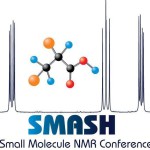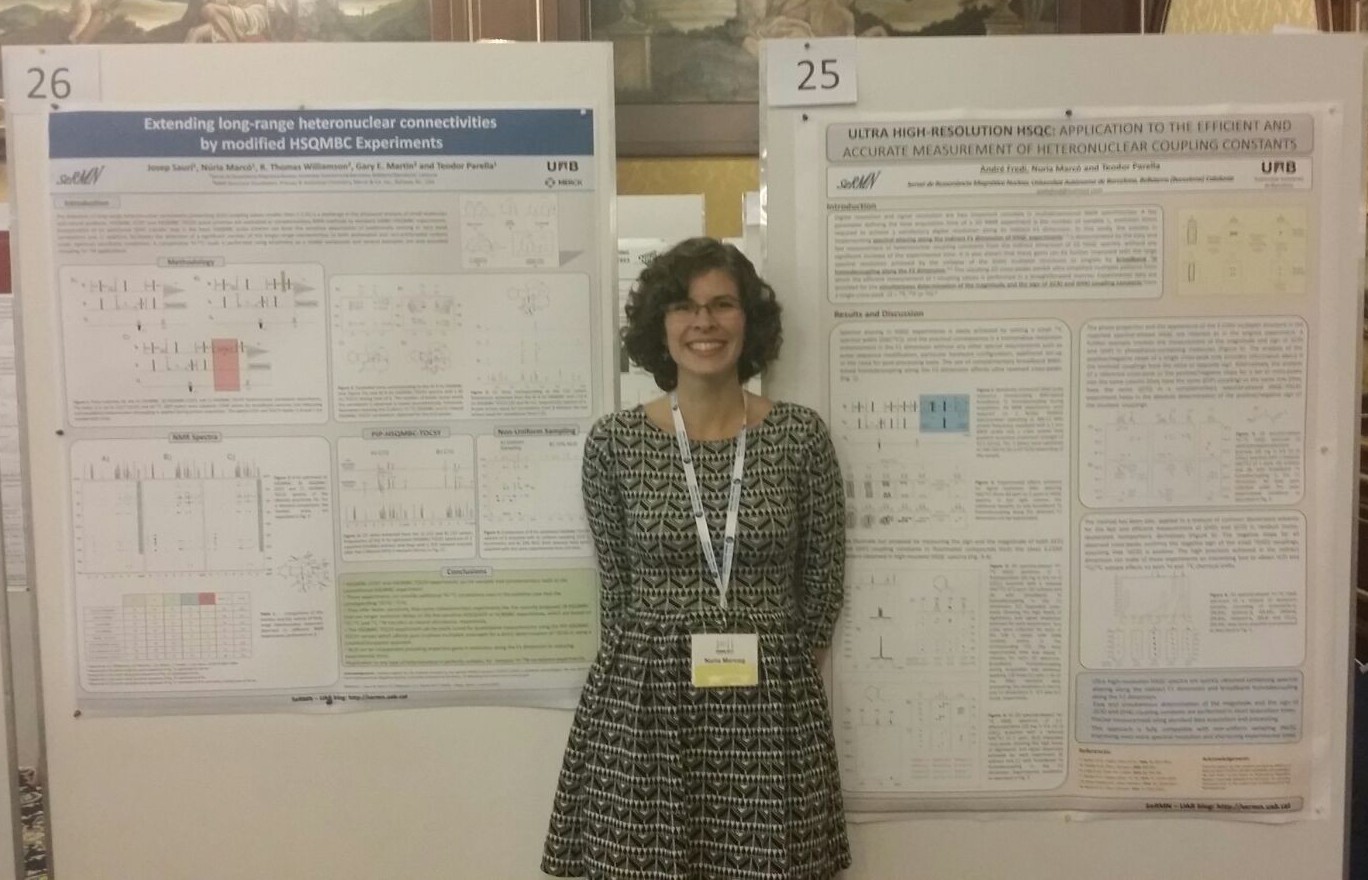Some of the SeRMN staff will present our last research works at the annual meeting of the European magnetic resonance community EUROMAR 2015 Conference that will take place from 5th to 10th July in Prague, Czech Republic. Find below a summary of our contributions.
Teodor Parella presents a lecture entitled “Modern Pure Shift NMR: Pros and Cons”.In recent years, a great interest in the development of new broadband 1H homonuclear decoupled techniques providing simplified JHH multiplet patterns has emerged again in the field of small molecule NMR. The resulting highly resolved 1H NMR spectra display resonances as collapsed singlets, therefore minimizing signal overlap and expediting spectral analysis. This tutorial aims at presenting the most recent advances in pure shift NMR spectroscopy, with a particular emphasis to the Zangger–Sterk experiment. A detailed discussion about the most relevant practical aspects in terms of pulse sequence design, selectivity, sensitivity, spectral resolution and performance will be provided. The implementation of the different reported strategies into traditional 1D and 2D NMR experiments will be described while several practical applications will also be reviewed.
He also presents three different posters:
Poster nº 174: “Homodecoupled 1,1- and 1,n-adequate NMR experiments: application to the structural elucidation of proton-deficient natural products”. Josep Saurí, Wolfgang Bermel, Alexei V. Buevich, Kirill A. Blinov, Maged H. M.Sharaf, Paul L. Schiff Jr, Teodor Parella, R. Thomas Williamson and Gary E. Martin.
Abstract: Pure shift NMR methods have recently been the subject of intense research focus. By collapsing homonuclear proton-proton couplings, resolution and experimental sensitivity both increase. Cryptospirolepine is the most structurally complex alkaloid discovered thus far from any Cryptolepis. Characterization of several degradants of the original sample a decade later called the validity of the originally proposed structure in question. We now wish to report the development of improved homodecoupled variants of 1,1- and 1,n-ADEQUATE (HD-ADEQUATE) and the utilization of these techniques in resolving long-standing structural questions associated with crytospirolepine. In addition, we evaluate the combination of NUS and homonuclear decoupling for the acquisition of both 1JCC and nJCC homonuclear coupling constants in related J-modulated ADEQUATE experiments.
Poster nº 177: “Extending long-range heteronuclear NMR connectivities by modified HSQMBC experiments”. Josep Saurí, Núria Marcó, R. Thomas Williamson, Gary E. Martin and Teodor Parella.
Abstract: The detection of long-range heteronuclear correlations associated with J(CH) coupling values smaller than 1-2 Hz is a challenge in the structural analysis of small molecules and natural products. LR-HSQMBC, HSQMBC-COSY and HSQMBC-TOCSY pulse schemes are evaluated as complementary NMR methods to standard HMBC/HSQMBC experiments. The re-optimization of the interpulse delay and the incorporation of an additional J(HH) transfer step in the HSQMBC pulse scheme can favor the sensitive observation of traditionally missing or very weak correlations and, in addition, facilitates the detection of a significant number of still longer-range connectivities to both protonated and non-protonated carbons under optimal sensitivity conditions. A comparative 1H-13C study is performed using strychnine as a model compound and several examples are also provided including 1H-15N applications.
Poster nº180: “Multiplicity-editing in long-range heteronuclear correlation experiments: application to natural products”.Josep Saurí, Eduard Sistaré, Michel Frederich, Alembert T. Tchinda, R. Thomas Williamson, Gary E. Martin and Teodor Parella.
Abstract: Even C/CH2 and odd CH/CH3 carbon-multiplicity information can be directly distinguished from the relative positive/negative phase of cross-peaks in a novel ME(Multiplicity-Edited)-selHSQMBC experiment. The method can be extended by a TOCSY propagation step, and is also fully compatible for the simultaneous and precise determination of long-range heteronuclear coupling constants. In addition, broadband homonuclear decoupling techniques can also be incorporated to enhance sensitivity and signal resolution by effective collapse of J(HH) multiplets. Strychnine, taxol, staurosporine, and sungucine are utilized as model compounds to demonstrate the usefulness of these techniques.
Laura Castañar presents a poster entitled “Ultra-high-resolved pure shift NMR experiments for the analysis of complex mixtures of compounds with near/identical 1H and 13C NMR spectra” (nº 202). Laura Castañar, Raquel Roldán, Pere Clapés, Albert Virgili and Teodor Parella.
Abstract: NMR analysis is often limited by the lack of appropriate signal dispersion due to small chemical-shift differences (Dd) and the wide JHH coupling patterns. In this work we present a useful experimental NMR strategy that greatly facilitates the analysis of highly congested spectral regions. We will show here how a real sample consisting of a mixture of several unknown compounds with near-identical 1H and 13C NMR spectra can be distinguished and assigned using ultra-high-resolution NMR methods based on the combination of pure shift NMR and spectral aliasing techniques. We use a suite of modern pure shift 2D NMR methods based on the homonuclear decoupling band-selective (HOBS) technique (HOBS-HSQC, HOBS-HSQC-TOCSY, and HOBS-HSQMBC experiments) in order to obtain fully homodecoupled signals for a set of non-mutually J-coupled protons resonating in a selected region of the 1H spectrum. Additionally, it is shown that using a reduced 13C spectral width of a few ppm (spectral aliasing approach), optionally combined with nonuniform sampling (NUS), can produce ultra-high-resolved 2D HOBS spectra in conventional acquisition times. The experimental results show that the full sensitivity and the excellent spectral resolution obtained from spectral-aliased 2D HOBS spectra makes it possible to enable the in situ distinction and assignment of similar organic compounds exhibiting near-identical 1H and 13C NMR spectra into the same mixture. It is also shown that a complete set of extremely small Dd(1H) and Dd(13C) values, even below the natural line width (1 and 5 ppb, respectively), can be simultaneously determined and assigned. The proposed strategy could also be very useful in other applications, such as the analysis of crude reactions and detection of intermediates, reaction monitoring, or the analysis of complex mixtures.
André Fredi presents a poster entitled “Ultra high-resolution HSQC: application to the efficient and accurate measurement of heteronuclear coupling constants” (nº 226). André Fredi, Núria Marcó and Teodor Parella.
Abstract: Digital resolution and signal resolution are two important concepts in multidimensional NMR spectroscopy. One of the more critical parameters defining the total acquisition time of a 2D NMR experiment is the number of variable t1 evolution times required to achieve a satisfactory digital resolution in its indirect F1 dimension. In this study, the success in implementing spectral aliasing along the indirect F1 dimension of HSQC experiments is demonstrated by the easy measurement of heteronuclear coupling constants from the indirect dimension of 2D HSQC spectra, without any significant increase of the experimental time. It is also shown that the gains of introducing aliasing are further improved with the large signal resolution achieved by the collapse of the J(HH) multiplet structure by broadband 1H homodecoupling in the F2 dimension. The resulting 2D cross-peaks exhibit ultra simplified multiplet patterns from which the measurement of the active J values is determined in a straightforward manner. Experimental data will be provided for the simultaneous determination of the magnitude and the sign of J(CX) and J(HX) coupling constants (X = 19F, 31P or 2H).
Albert Gargallo presents a poster entitled “Ecometabolomic study of plant shoots/roots responses to drought” (nº 232). Albert Gargallo Garriga, Jordi Sardans, Míriam Pérez Trujillo, Teodor Parella and Josep Peñuelas.
Abstract: Ecometabolomics aims to analyse the metabolome of the plant, i.e. the total number of metabolites, and their shifts in response to environmental changes. Ecometabolomics has recently been used to monitor the phenotypic changes of a particular genotype in response to the drivers of global change, particularly shifts in temperature. When a stress treatment – or different stresses occurring simultaneously like in real field conditions – is applied to a plant, plant organs can respond differently. Shoots are autotrophic and roots heterotrophic organs of plants with different physiological functions. Roots and shoots can respond asymmetrically, as has been observed at the morphological level, e.g. shifts in the shoot/root biomass and growth-rate ratios occur when the availability of soil water changes. In this work NMR- and LC-MS-based ecometabolomics together with stoichiometric analysis were used to study and compare the metabolism of plant shoots and roots and their different responses to drought. The study was performed with two common grass species (Holcus lanatus L. and Alopecurus pratensis L.) 1H NMR fingerprinting of all 400 individuals and metabolic profiling – based on the assignment of peaks through 2D NMR spectroscopy – was carried out. Results pinpointed the differences between shoot and root metabolomes and stoichiometries. Principal component analyses (PCAs) of both metabolomic and stoichiometric data indicates the highest variability among species and seasons of shoot with respect to root metabolome. These results were confirmed by PERMANOVA analysis. In addition, the metabolic response of shoots to drought contrasts with that of roots; shoots decrease their growth metabolism (lower concentrations of sugars, amino acids, nucleosides, N, P, and K), while roots increase it in a mirrored response. Shoots are metabolically deactivated during drought to reduce the consumption of water and nutrients, whereas roots are metabolically activated to enhance the uptake of water and nutrients, buffering together the effects of drought, at least at the short term. The study shows the suitability of the combination of NMR- and LC-MS-based metabolomics.
Eva Monteagudo presents a poster entitled “A benzyl alcohol derivative of BDPA radical for fast dissolution dynamic nuclear polarization NMR spectroscopy” (nº 371). José Luís Muñoz-Gómez, Eva Monteagudo, Vega Lloveras, Teodor Parella, Jaume Veciana and José Vidal-Ganzedo.
Abstract: The synthesis, structural characterization and the successful application of a carbon centered radical derived from 1,3-bisdiphenylene-2-phenylallyl (BDPA), its benzyl alcohol derivative (BA-BDPA), as a polarizing agent for fast dissolution Dynamic Nuclear Polarization (DNP) are described. The reported BA-BDPA radical meets all the requirements to become a promising candidate for its use in in-vivo DNP-NMR experiments: it is soluble into neat [1-13C]pyruvic acid, insoluble in the dissolution transfer solvent and effective as a polarizing agent in fast dissolution DNP-NMR applications, without the need of using glassing agents. Moreover, it enables a simple but effective in-line radical filtration to obtain hyperpolarized solutions of [1-13C]pyruvic acid free of radicals, that offer a much better polarization performance.







